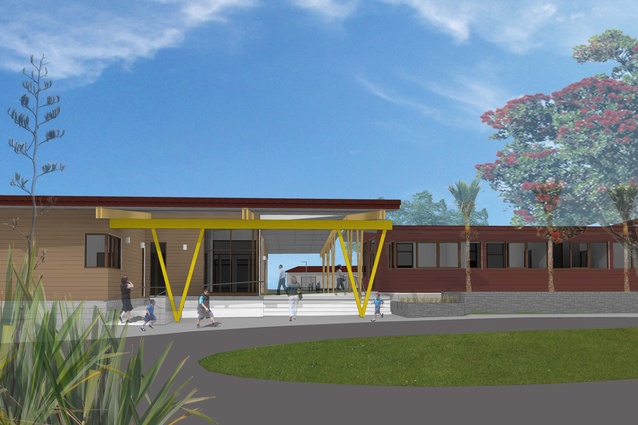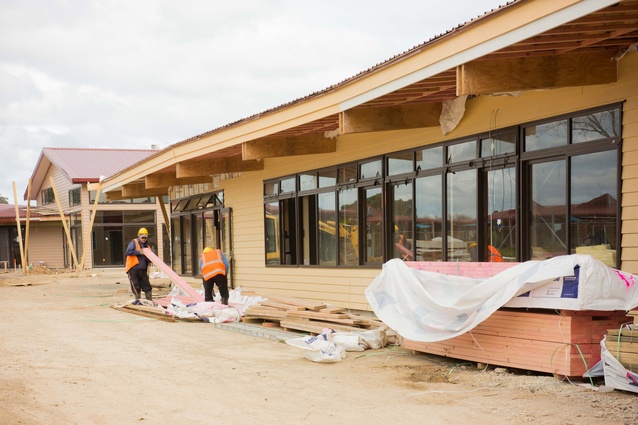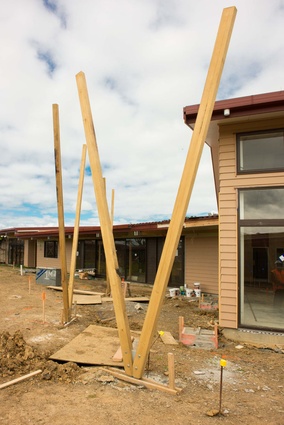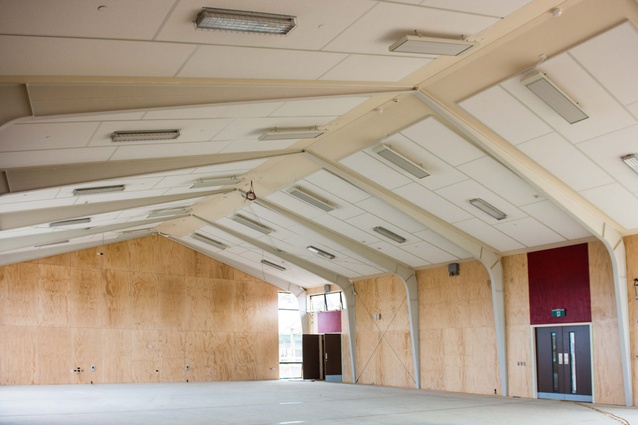Green lessons
A full Mãori language immersion school, Auckland’s Te Kura Kaupapa Maori o Puau Te Moananui-a-Kiwa, is a Year 1-13 school with a role of about 120 serving the communities of Glen Innes through to Orakei.
Located on the former site of Glen Innes Intermediate School on Farringdon Street, which was shut by the Ministry of Education in 2003, the kura has seen a steady growth in student numbers, and as a result decided to upgrade and expand its ageing facilities.
Arrow International arrived on site in January 2014. The construction team worked alongside fully operational classrooms and teaching areas, and an adjoining operational kohunga reo on a $7.1 million project in which two new state-of-the-art structures were constructed, and by January 2015, three buildings will be demolished and the grounds landscaped.
The job presented various challenges for the Arrow team: asbestos was present in a number of the buildings flagged for demolition; the site was tightly bordered by operational learning areas, and the buildings were required to be built to achieve a 5 Green Star certification.
And that is not to mention the structural aspects. The two new single-level buildings each presented their own challenges. The community building, to the south, which incorporates the gymnasium, food technology areas, a sick bay, offices and administration rooms, was constructed using a concrete slab on grade supporting traditional timber framing. Thorne Dwyer structural engineer Guy Wood said the re-use of an existing 60-year-old steel portal-framed structure for the gymnasium introduced some complexity into this building.
“The existing structure, built in the 1950s, consisted of a series of three-pin portal frames at 3.65 metre crs, spanning 15 metres and approximately 6.5 metres high at the apex,” he said. “Once the grade of steel used had been established, the frames were analysed using SPACE GASS software and were found to be more than adequate under the current loading requirements for vertical and lateral loads.”
New rod bracing was installed in the roof plane and side walls, and the timber roof and walls were replaced. A new concrete slab was poured over the existing slab and a damp proof membrane was installed between them.
Interestingly, this building also incorporates a lobby designed specifically for the blessing of the buildings, during which for cultural reasons people are required to enter the structure through an entrace facing north east, as this lobby does.
The other building, to the north, Whare Kura, incorporates open-plan learning areas, specialised laboratories incorporating a fume cupboard, a library and various other teaching rooms.
In the Whare Kura building, large uninterrupted floor areas were required with a complex roof shape of various angles, four-metre cantilevered eaves, and a central 10x8 metre courtyard.
“A timber solution was adopted using two rows of 10-metre-wide portal frames, connected with a lower-level 10-metre rafter, which dropped out over the courtyard area. Pairs of 400x63 HySpan were used as the portal rafters, fixed either side of 400x90 HySpan legs,” Wood said.
“Knee connections consisted of a pair of 6mm steel plates with rows of timber rivets to create a moment-resisting joint between the rafters and the leg.”
By utilising timber rivets, which differ from traditional nailed connections in that the head of the rivet has a wedge shape that becomes lodged in the pre-drilled holes in the steel, virtually eliminating slip, it was possible to achieve a very stiff connection.
Requirements relating to the blessing of the site meant both buildings needed to be completed, and delivered, at the same time, which resulted in the project team managing both builds simultaneously.
The two new buildings stand six metres apart; between them visitors will walk through a laneway to enter the reception area in Whare Kura. A shade structure running the length of the two buildings following the roof line acts as an extended roof, although it is not connected to the building at any point. Instead, it stands on posts, which provide an interesting frontage to the buildings.
Both buildings are constructed in timber: the choice to utilise timber was partly as a result of the Green Star requirement, Arrow site manager Mark Bennett said. “About 90 per cent of the timber is sustainable and comes from FSC-certified mills. All paints are low VOC and sealants and other materials are non-toxic,” he said. “In addition, water from the roof is collected and stored in a harvesting tank, and will be used for the buildings’ non-potable water needs.”
Lilac-coloured piping is indicative of non-potable water in both buildings. Project manager Scott Taucher said most of the interior of Whare Kura was covered in a composition board, which turned the walls into “giant pinboards” but also provided accoustic qualities, as part of the Green Star requirements.
Another crucial aspect of aiming to achieve a 5 Green Star rating was the requirement that waste materials did not leave the site, and all construction materials were recycled, including wood, plastic, pellets and cable rounds. The fill removed under the footprint of the buildings will eventually be used in the landscaping of the buildings’ surrounds.
“The roof in the Whare Kura building was a bit of a challenge. There were a lot of really critical junctions, as a result of the four different areas of the building, where it would be easy to get water ingress,” Taucher said. It is from the internal courtyard where these junctions are the most predominant; the varying pitches of the different areas meet here.
But perhaps the most visually stunning area of the kura’s new buildings is the gymnasium’s interior – part of the community building, which also incorporates a food technology room, sick bay, offices and staff facilities. It has a whale bone-like internal structure created by the portals retained from the original structure.
“The hall was designed to house 500 people for ceremonies and events, but it is also fire-rated for sleeping as the kura holds events in which members of the community sleep at the school,” Taucher said. A mattress storeroom is located off one side of the hall.
When Progressive Building visited the site, the hall was complete, apart from the floor and audio-visual system. Copper coils had just been attached to the floor, which will amplify sound from ceiling speakers for children with hearing aids, Taucher said.
Because of the asbestos present in the former kohanga reo building, the Arrow team will wait until the kindergarten, now based in a new, adjacent building, shuts down over Christmas to demolish the old building, and complete this unique project.













